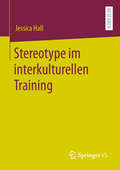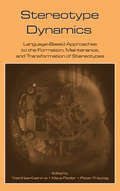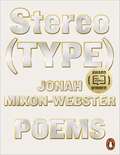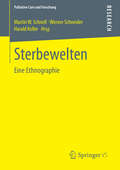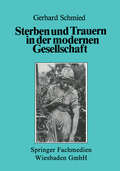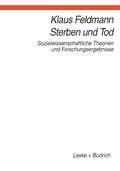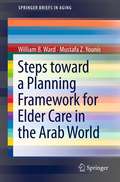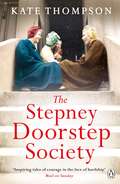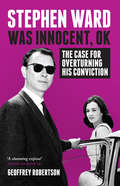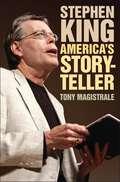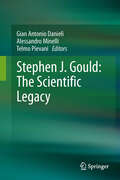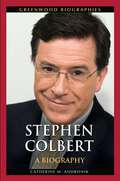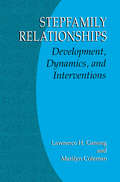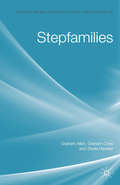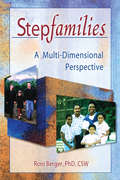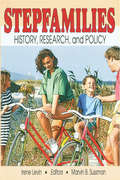- Table View
- List View
Stereotype im interkulturellen Training
by Jessica HaßDie Arbeit interkultureller Trainerinnen und Trainer steht dem scheinbar unüberbrückbaren Dilemma zwischen dem Bedürfnis der Teilnehmenden nach Orientierung einerseits und dem eigenen Anspruch an angemessene Komplexität andererseits gegenüber. Stereotype helfen dabei, die Welt zu ordnen und zu verstehen, gleichzeitig führen sie jedoch zu Ausgrenzung und engen unsere Wahrnehmungsmöglichkeiten ein. In der theoretisch fundierten Analyse der aktuellen Praxis interkultureller Trainings in Deutschland sucht Jessica Haß zu ergründen, wie interkulturelles Training vor dem Hintergrund eines offenen und dynamischen Kulturverständnisses gelingen kann.
Stereotype Dynamics: Language-Based Approaches to the Formation, Maintenance, and Transformation of Stereotypes
by Yoshihisa Kashima Klaus Fiedler Peter FreytagThis volume addresses the role of communication in stereotype dynamics, while placing the phenomenon of social stereotypes appropriately in the socio-cultural context. Stereotype Dynamics assembles top researchers in the field to investigate stereotype formation, maintenance, and transformation through interpersonal facets of communication.Section
Stereotype Dynamics: Language-Based Approaches to the Formation, Maintenance, and Transformation of Stereotypes
by Yoshihisa Kashima Klaus Fiedler Peter FreytagThis volume addresses the role of communication in stereotype dynamics, while placing the phenomenon of social stereotypes appropriately in the socio-cultural context. Stereotype Dynamics assembles top researchers in the field to investigate stereotype formation, maintenance, and transformation through interpersonal facets of communication.Section
Stereo(TYPE)
by Jonah Mixon-WebsterThe award-winning poet's darkly riotous debut, exploring stereotypes of Black male identity and sexuality in a corrupt systemLyrical, loud and radically urgent, Jonah Mixon-Webster's debut aims its sights at the words and images that shape us and the corrupt forces that stand in the way of our freedom. Stereo(TYPE) is a reckoning and a force. It is a revision of our most sacred mythologies - and a work of documentary poetry reporting from Mixon-Webster's hometown of Flint, Michigan, where untainted tap water is still not guaranteed and the legacies of racist policies persist. Challenging stereotypes through scenes scattered with satire, violence, and the extreme vagaries of everyday life, Mixon-Webster explores the places where space and body, race and region and sexuality and class meet and intersect. He invents visual/sonic forms, recasts poems as FAQs and transcripts, and dives into dreamscapes and modern tragedies. Interrogating language and the ways we wield it as both sword and shield, Stereo(TYPE) is a rapturous collection of vital and beautiful poems.
Sterbewelten: Eine Ethnographie (Palliative Care und Forschung)
by Martin W. Schnell Harald Kolbe Werner SchneiderHirntoddiagnostik, Palliative Care u.a. sind kulturelle und gesellschaftliche Techniken, die das Sterben und den Tod heute bestimmen. Sterben ist daher kein rein biologischer, sondern primär ein sozialer Prozess. Die Weiterlebenden definieren, wann jemand als sterbend, als tot gilt und was mit ihm zu geschehen hat – somit steht dabei nicht nur das sterbende Individuum im Mittelpunkt, sondern interaktiv hergestellte Sterbewelten. Die Methode der Ethnographie zeigt, wie diese Sterbewelten gesellschaftlich aufgebaut werden. Entlang der vorgestellten Methodik sowie ausgewählten empirischen Beispielen zeigen die AutorInnen, dass und wie die aktuelle Institutionalisierung des Sterbens den Menschen als ein Subjekt formt, das rechtzeitig seine sogenannten letzten Dinge regeln muss, um den heutigen Vorgaben des ‚guten‘ Sterbens folgen zu können.
Sterben und Trauern in der modernen Gesellschaft
by Gerhard SchmiedDas vorliegende Buch will in erster Linie Informationen zu Sterben, Tod und Trauern vermitteln, und darunter sol che, die bisher in deutscher Sprache noch nicht zugänglich waren. Es soll auch helfen. Kann Information jemand hel fen? Aus eigenem Erleben weiß ich, daß die sachliche, auch wissenschaftliche Auseinandersetzung mit Tod und Trauer die Bewältigung eines Verlustes erleichtern kann. Und vor allem ist Information oft die Voraussetzung für wirkliche Hilfe, die mehr ist als das Bemühen. Der Autor ist Soziologe, und die daraus resultierende wissenschaftliche Orientierung ist leitend, wenn für unse ren gegenwärtigen Lebensraum, die westlichen Industrie gesellschaften, Eigenarten und Probleme von Sterben, Tod und Trauern sowie ihre Einbettung in die Gesamtkultur dargelegt werden. Das bedeutet jedoch kein striktes Aus klammern der historischen Sichtweise. Im Kontrast zur Vergangenheit werden vielfach erst Besonderheiten von Sterben, Tod und Trauer in der Gegenwart deutlich; bis weilen wird aus dieser Perspektive aber auch sichtbar, daß manche Züge gar nicht so typisch modern sind, wie man auf den ersten Blick annimmt.
Sterben und Tod: Sozialwissenschaftliche Theorien und Forschungsergebnisse
by Klaus Feldmann"Wenn mittels des Elektroencephalogramms (EEG) die für das lebende Großhirn typischen elektrischen Entladungen nicht mehr festgestellt werden können, wenn datiiber hinaus auch über die Verschaltungen zu den stammesgeschichtlich alten Teilen des Gehirns im sogenannten Hirnstamm keine Reflexe mehr ausgelöst werden können und die Blutzirkulation im Gehirn zum Stillstand gekommen ist, gilt das unter Ärzten seit etwa zwei Jahrzehnten als das sicherste Zeichen, daß der Tod eingetreten ist. " (Schiefenhövel 1993, 37) Es klingt eigentümlich, aber der Satz "Das einzige, was gewiß ist, ist der Tod," ist falsch, Bei einem Tier stellen wir als Laien ohne Zögern den Tod fest, bei einem Menschen ist dies eine professionelle Angelegenheit, also nur wenige auserwählte Personen sind hierfür befugt Und es herrscht keine Ei nigkeit darüber, ob der ganze Mensch oder nur ein Teil von ihm tot ist In anderen Kulturen wurden Menschen für tot erklärt, die in unserer Gesell schaft für lebendig gehalten werden. Todesdefinitionen sind also kulturell vermittelt Die Hirntoddefinition deutet auf den Wandel im vorherrschenden Men schenbild hin - Bewußtsein, zentrale Steuerung, Rationalität. Die gesell schaftliche Anerkennung der Definition über den Gehirntod erwies sich für den Fortschritt der Medizin, z. B. für die erfolgreiche Durchführung von Or gantransplantationen, als notwendige Voraussetzung. Nur das Gehirn ist we sentlich für den "modernen" Menschen, die anderen Körperteile sind ersetz bar, ohne daß es zu einem Identitätsverlust kommt Das traditionelle japani sche Menschenbild geht dagegen von einer untrennbaren Einheit der Körper teile aus, da sonst die Identität gefährdet ist (Ohnuki-Tierney 1994).
Sterben und Tod: Geschichte – Theorie – Ethik. Ein interdisziplinäres Handbuch
by Klaus Feldmann Udo Tworuschka Joachim WittkowskiZentrale ethische Frage im 21. Jahrhundert: Wie gehen wir am besten mit Altern, Sterben und Tod um? Erstmals werden die Erkenntnisse verschiedener Wissenschaften dazu in einem Handbuch zusammengefasst. Es vermittelt grundlegende Kenntnisse über medizinische, psychologische, historische und ethische Aspekte von Sterben und Tod und beleuchtet religionswissenschaftliche, ethnologische und philosophische Perspektiven. Sowohl der individuelle als auch der gesellschaftliche Umgang mit dem Thema kommen zur Sprache, ebenso wie moralische Debatten, z. B. zu Suizid und Todesstrafe.
Sterbehilfepolitik in Deutschland: Eine Einführung (essentials)
by Caroline PreidelCaroline Preidel befasst sich mit der Sterbehilfepolitik in Deutschland – sie gibt damit eine Einführung in ein Feld der deutschen Moralpolitik. Die Autorin definiert, welche Formen der Sterbehilfe es gibt, und beleuchtet die Konfliktdimensionen des Politikfelds. Anschließend erörtert sie, wie Deutschland und die anderen Länder Europas mit diesem moralisch aufgeladenen und komplexen Thema umgehen. Zudem wirft die Autorin einen detaillierten Blick auf die deutsche Regulierungsgeschichte und analysiert die Ursachen für die Reformbehäbigkeit Deutschlands in der Sterbehilfepolitik.
Steps Toward a Planning Framework for Elder Care in the Arab World (SpringerBriefs in Aging)
by William B. Ward Mustafa Z. YounisThis book reviews the elder care literature pertaining to the Arab world and proposes steps that can be taken to improve the health and quality of life of older people in this region. Organized in three main sections (Program Assessment, Program Planning, Conclusions and Recommendations), the book addresses such topics as developing a conceptual framework; Arab world elder demographics; quality of life issues; demand for services; training issues; training capacity and capabilities; and conclusions and recommendations for improving the health of older persons in the Arab world. While the countries of the Arab world have the advantage of a unified language and culture that can be used to expedite development of area-wide approaches to a system of elder care, the lack of economic and political unification (such as common market and open trade) along with institutionalized age discrimination (some Arab countries restrict hiring for government and private jobs to persons younger than 45) present barriers to improving the health of older people. In addition, modernization and ease of transportation have resulted in a heavy focus on Western-style fast food, with an accompanying increase in chronic diseases such as hypertension, cardiovascular disease, diabetes, and cancer.
Steps to an Ecology of Mind: Collected Essays in Anthropology, Psychiatry, Evolution, and Epistemology
by Gregory BatesonGregory Bateson was a philosopher, anthropologist, photographer, naturalist, and poet, as well as the husband and collaborator of Margaret Mead. With a new foreword by his daughter Mary Katherine Bateson, this classic anthology of his major work will continue to delight and inform generations of readers. "This collection amounts to a retrospective exhibition of a working life. . . . Bateson has come to this position during a career that carried him not only into anthropology, for which he was first trained, but into psychiatry, genetics, and communication theory. . . . He . . . examines the nature of the mind, seeing it not as a nebulous something, somehow lodged somewhere in the body of each man, but as a network of interactions relating the individual with his society and his species and with the universe at large."—D. W. Harding, New York Review of Books "[Bateson's] view of the world, of science, of culture, and of man is vast and challenging. His efforts at synthesis are tantalizingly and cryptically suggestive. . . .This is a book we should all read and ponder."—Roger Keesing, American Anthropologist
Steps to an Ecology of Mind: Collected Essays in Anthropology, Psychiatry, Evolution, and Epistemology
by Gregory BatesonGregory Bateson was a philosopher, anthropologist, photographer, naturalist, and poet, as well as the husband and collaborator of Margaret Mead. With a new foreword by his daughter Mary Katherine Bateson, this classic anthology of his major work will continue to delight and inform generations of readers. "This collection amounts to a retrospective exhibition of a working life. . . . Bateson has come to this position during a career that carried him not only into anthropology, for which he was first trained, but into psychiatry, genetics, and communication theory. . . . He . . . examines the nature of the mind, seeing it not as a nebulous something, somehow lodged somewhere in the body of each man, but as a network of interactions relating the individual with his society and his species and with the universe at large."—D. W. Harding, New York Review of Books "[Bateson's] view of the world, of science, of culture, and of man is vast and challenging. His efforts at synthesis are tantalizingly and cryptically suggestive. . . .This is a book we should all read and ponder."—Roger Keesing, American Anthropologist
Steppin' Out: New York Nightlife and the Transformation of American Culture
by Lewis A. ErenbergThe evolution of New York nightlife from the Gay Nineties through the Jazz Age was, as Lewis A. Erenberg shows, both symbol and catalyst of America's transition out of the Victorian period. Cabaret culture led the way to new styles of behavior and consumption, dissolving conventional barriers between classes, races, the sexes—even between life and art. A fabulous era of chorus girls, jazz players, lobster palaces, and hip flasks—the age of Sophie Tucker, Irene and Vernon Castle, and Gilda Gray—tangos through the pages of this ground-breaking, as well as entertaining, cultural history.
The Stepney Doorstep Society: The remarkable true story of the women who ruled the East End through war and peace (A\history Of Urban Society In Europe Ser.)
by Kate ThompsonThe unsung and remarkable stories of the women who held London's East End together during not one, but two world wars._____________Minksy, Gladys, Beatty, Joan, Girl Walker. While the men were at war, these women ruled the streets of the East End. Brought up with firm hand in the steaming slums and teeming tenements, they struggled against poverty to survive, and fought for their community in our country's darkest hours.But there was also joy to be found. From Stepney to Bethnal Green, Whitechapel to Shoreditch, the streets were alive with peddlers and market stalls hawking their wares, children skipping across dusty hopscotch pitches, the hiss of a gas lamp or the smell of oxtail stew. You need only walk a few steps for a smile from a neighbour or a strong cup of tea.From taking over the London Underground, standing up to the Kray twins and crawling out of bombsites, The Stepney Doorstep Society tells the vivid and moving stories of the matriarchs who remain the backbone of the East End to this day.
Stephen Ward Was Innocent, OK: The Case for Overturning His Conviction
by Geoffrey RobertsonIn the summer of '61 John Profumo, Minister for War, enjoyed a brief affair with Christine Keeler... Late in the afternoon of Wednesday 31 July 1963, Dr Stephen Ward was convicted at the Old Bailey on two counts alleging that he lived on the earnings of a prostitute. He was not in the dock but comatose in hospital. The previous night he had attempted suicide, because (as he said in a note) 'after Marshall's [the judge's] summing up, I've given up all hope'. He died on Saturday 3 August, without regaining consciousness. Many observers of the proceedings thought the convictions did not reflect the evidence and that the trial was unfair, and this book will show that it breached basic standards of justice. Geoffrey Robertson brings his forensic skills and a deeply felt sense of injustice to the case at the heart of the Profumo affair, the notorious scandal that brought down a government.
Stephen King: America's Storyteller (Non-ser.)
by Tony MagistraleThis analysis of the work of Stephen King explores the distinctly American fears and foibles that King has celebrated, condemned, and generally examined in the course of his wildly successful career.Stephen King: America's Storyteller explores the particular American-ness of Stephen King's work. It is the first major examination to follow this defining theme through King's 40-year career, from his earliest writings to his most recent novels and films made from them.Stephen King begins by tracing Stephen King's rise from his formative years to his status as a one of the most popular writers in publishing history. It then takes a close look at the major works from his canon, including The Shining, The Stand, It, Dolores Claiborne, and The Dark Tower. In these works and others, author Tony Magistrale focuses on King's deep rooted sense of the American experience, exemplified by his clear-eyed presentation of our historical and cultural foibles and scars; his gallery of unlikely friendships that cross race, age, and class boundaries; and his transcendent portrayals of uniquely American survival instincts, fellowship, and acts of heroism from the least likely of sources.
Stephen J. Gould: The Scientific Legacy
by Gian Antonio Danieli, Alessandro Minelli and Telmo PievaniStephen J. Gould’s greatest contribution to science is a revised version of the theory of evolution which offers today a useful framework for understanding progress in many evolutionary fields. His intuitions about the conjunction of evolution and development, the role of ecological factors in speciation, the multi-level interpretation of the units of selection, and the interplay between functional pressures and constraints all represent fruitful lines of experimental research. His opposition to the progressive representations of evolution, the gene-centered view of natural history, or the adaptationist “just-so stories” has also left its mark on current biology. In May 2012, at the Istituto Veneto di Scienze, Lettere ed Arti in Venice, an international panel of scientists and philosophers discussed Stephen J. Gould’s legacy, ten years after his death. This book presents a selection of those contributions, chosen for their interest and importance. A broad range of themes are covered: Gould’s contribution to evolutionary theory, including the concept of punctuated equilibria and the importance of his pluralism; the Gouldian view of genome and development; Gould’s legacy in anthropology; and, finally, the significance of his thought for the human sciences.This book provides a fascinating appraisal of the cultural legacy of one of the world’s greatest popular writers in the life sciences. This is the first time that scientists including some of Gould’s personal friends and co-authors of papers of momentous importance such as Niles Eldredge have come together to strike a balanced view of Gould's intellectual heritage.
Stephen Colbert: A Biography (Greenwood Biographies)
by Catherine M. AndronikThis book explores how comedian Stephen Colbert's satiric views of American life have captured the imagination of viewers around the world—and sharpened these individuals' own critical interpretations and opinions on current events.Stephen Colbert may be "just a comedian"—one not all audiences find funny, especially among those who have been mercilessly lampooned by him—but there is no arguing that the condescending, bombastic, and largely ignorant pundit he plays on Comedy Central has brought awareness of current events and political happenings to a substantially larger portion of the American population.The only available biography on Stephen Colbert, this book examines his life story and details how he became one of the most influential people on current American culture. Beginning with coverage of Colbert's childhood, the chapters discuss his education, highlighting his interest in drama; describe his introduction to the world of comedy; review his contributions as a "correspondent" on The Daily Show with Jon Stewart; and focus on Colbert's accomplishments and antics as the star of his faux news program that debuted in the fall of 2005, The Colbert Report.
Stephen Colbert: A Biography (Greenwood Biographies)
by Catherine M. AndronikThis book explores how comedian Stephen Colbert's satiric views of American life have captured the imagination of viewers around the world—and sharpened these individuals' own critical interpretations and opinions on current events.Stephen Colbert may be "just a comedian"—one not all audiences find funny, especially among those who have been mercilessly lampooned by him—but there is no arguing that the condescending, bombastic, and largely ignorant pundit he plays on Comedy Central has brought awareness of current events and political happenings to a substantially larger portion of the American population.The only available biography on Stephen Colbert, this book examines his life story and details how he became one of the most influential people on current American culture. Beginning with coverage of Colbert's childhood, the chapters discuss his education, highlighting his interest in drama; describe his introduction to the world of comedy; review his contributions as a "correspondent" on The Daily Show with Jon Stewart; and focus on Colbert's accomplishments and antics as the star of his faux news program that debuted in the fall of 2005, The Colbert Report.
Stepfamily Relationships: Development, Dynamics, and Interventions
by Lawrence H. Ganong Marilyn ColemanThis volume focuses on a wide range of behaviors and outcomes in stepfamily relationships, both positive and negative. The authors use the normative-adaptive perspective to seek out and study adaptive, well-functioning stepfamilies and find how they differ from those who struggle to cope. It will be a welcome text and reference for all those who study and work with stepfamilies and families in general.
Stepfamilies (Palgrave Macmillan Studies in Family and Intimate Life)
by G. Allan G. Crow S. HawkerDrawing on recent developments within the sociology of family life, this book examines family connection and solidarity within different stepfamily networks, focusing on relationships from a kinship perspective and using case studies of people's experiences to explore how family connection is constructed within different stepfamilies.
Stepfamilies: A Multi-Dimensional Perspective
by Roni BergerCombining theoretical, empirical, and clinical knowledge, Stepfamilies: A Multi-Dimensional Perspective contains recent research and information that will help mental health practitioners, family therapists, psychologists, and counselors understand the characteristics, dynamics, needs, and issues of nonclinical stepfamilies. Based on direct experiences with diverse types of stepfamilies, this book gives you new guidelines and strategies that will enable you to offer more successful sessions to your clients and improve your effectiveness as a practitioner. Developed to give you a more realistic understanding of stepfamilies, this text helps you avoid the stereotypes and false perceptions that often surround stepfamilies. Offering methods and strategies aimed at making your clients feel comfortable about themselves and their situations, Stepfamilies: A Multi-Dimensional Perspective examines several aspects of these families that you need to know in order to improve your effectiveness with them, including: the definition and description of stepfamilies and recognizing historical and social changes in the stepfamily structure critical reviews on the present knowledge of stepfamilies describing the complexity of family structure, the ambiguity of boundaries and roles, and the struggle with the diverse phases of the life cycle discussing key issues for stepfamilies, such as past orientation and acceptance/rejection of differences from non-stepfamilies and focal subsystems the profile, characteristics, and case studies of an innovative typology of stepfamilies that includes integrated families, invented families, and imported families aspects of ethnically and culturally different stepfamilies, including American stepfamilies, Israeli stepfamilies, and immigrant stepfamilies from the former Soviet Union social perceptions and attitudes of stepfamilies in schools, social services, community organizations, the media, and with the lawOffering case studies and data on a variety of families and situations, Stepfamilies: A Multi-Dimensional Perspective will show you that all stepfamilies are not the same and cannot be helped by just one practice method. Complete with principles and instruments to assess patients and the success of sessions, Stepfamilies: A Multi-Dimensional Perspective works to promote an understanding of stepfamilies that will result in effective and positive therapy for your clients.
Stepfamilies: A Multi-Dimensional Perspective
by Roni BergerCombining theoretical, empirical, and clinical knowledge, Stepfamilies: A Multi-Dimensional Perspective contains recent research and information that will help mental health practitioners, family therapists, psychologists, and counselors understand the characteristics, dynamics, needs, and issues of nonclinical stepfamilies. Based on direct experiences with diverse types of stepfamilies, this book gives you new guidelines and strategies that will enable you to offer more successful sessions to your clients and improve your effectiveness as a practitioner. Developed to give you a more realistic understanding of stepfamilies, this text helps you avoid the stereotypes and false perceptions that often surround stepfamilies. Offering methods and strategies aimed at making your clients feel comfortable about themselves and their situations, Stepfamilies: A Multi-Dimensional Perspective examines several aspects of these families that you need to know in order to improve your effectiveness with them, including: the definition and description of stepfamilies and recognizing historical and social changes in the stepfamily structure critical reviews on the present knowledge of stepfamilies describing the complexity of family structure, the ambiguity of boundaries and roles, and the struggle with the diverse phases of the life cycle discussing key issues for stepfamilies, such as past orientation and acceptance/rejection of differences from non-stepfamilies and focal subsystems the profile, characteristics, and case studies of an innovative typology of stepfamilies that includes integrated families, invented families, and imported families aspects of ethnically and culturally different stepfamilies, including American stepfamilies, Israeli stepfamilies, and immigrant stepfamilies from the former Soviet Union social perceptions and attitudes of stepfamilies in schools, social services, community organizations, the media, and with the lawOffering case studies and data on a variety of families and situations, Stepfamilies: A Multi-Dimensional Perspective will show you that all stepfamilies are not the same and cannot be helped by just one practice method. Complete with principles and instruments to assess patients and the success of sessions, Stepfamilies: A Multi-Dimensional Perspective works to promote an understanding of stepfamilies that will result in effective and positive therapy for your clients.
Stepfamilies: History, Research, and Policy
by Marvin B SussmanStepfamilies: History, Research, and Policy examines language use, laws, cultural stereotypes, media images, and social policies and practices to create an understanding of how predominant views about stepfamilies and stepfamily members are constructed within society. As the rates of divorce and remarriage continue to increase, it is more important than ever to overcome nuclear family ideology and abandon the model of research that compares stepfamilies with nonstepfamilies. This book shows you how honor and empowerment can be attained in new family structures and how alternative kin networks can be just as healthy as the traditional nuclear family unit.As this book examines the ability of different societies to integrate different family forms into mainstream notions of “family,” you will realize the damaging effects of treating stepfamilies as incomplete, undesirable institutions. In fact, Stepfamilies: History, Research, and Policy will challenge your notions of family over and over again, as it discusses: key relationships in stepfamilies stepfather involvement in parenting after remarriage meaning of gender in a stepfamily differences in “investment” between biological and nonbiological parents demographic change and significant shifts in the social and cultural implications of stepfamilies attempting to reconstruct a household like that of a previous marriage the impact of stereotypes on the internal dynamics of stepfamilies and on the interactions of stepfamilies with outsiders the absence of guidelines and cultural norms for role performance and problem solving in stepfamiliesStepfamilies: History, Research, and Policy discusses both the difficulties of forming new families and households as well as the factors that promote family cohesiveness and integration in stepfamilies. From stereotypes of stepmothers to ambiguous legal relationships to child maltreatment in stepfamilies to sibling relations, there isn’t much that the penetrating lens of this book leaves uncovered.
Stepfamilies: History, Research, and Policy
by Marvin B SussmanStepfamilies: History, Research, and Policy examines language use, laws, cultural stereotypes, media images, and social policies and practices to create an understanding of how predominant views about stepfamilies and stepfamily members are constructed within society. As the rates of divorce and remarriage continue to increase, it is more important than ever to overcome nuclear family ideology and abandon the model of research that compares stepfamilies with nonstepfamilies. This book shows you how honor and empowerment can be attained in new family structures and how alternative kin networks can be just as healthy as the traditional nuclear family unit.As this book examines the ability of different societies to integrate different family forms into mainstream notions of “family,” you will realize the damaging effects of treating stepfamilies as incomplete, undesirable institutions. In fact, Stepfamilies: History, Research, and Policy will challenge your notions of family over and over again, as it discusses: key relationships in stepfamilies stepfather involvement in parenting after remarriage meaning of gender in a stepfamily differences in “investment” between biological and nonbiological parents demographic change and significant shifts in the social and cultural implications of stepfamilies attempting to reconstruct a household like that of a previous marriage the impact of stereotypes on the internal dynamics of stepfamilies and on the interactions of stepfamilies with outsiders the absence of guidelines and cultural norms for role performance and problem solving in stepfamiliesStepfamilies: History, Research, and Policy discusses both the difficulties of forming new families and households as well as the factors that promote family cohesiveness and integration in stepfamilies. From stereotypes of stepmothers to ambiguous legal relationships to child maltreatment in stepfamilies to sibling relations, there isn’t much that the penetrating lens of this book leaves uncovered.
